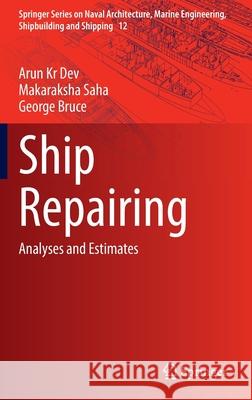Ship Repairing: Analyses and Estimates » książka



Ship Repairing: Analyses and Estimates
ISBN-13: 9789811694677 / Angielski / Twarda / 2022 / 298 str.
Ship Repairing: Analyses and Estimates
ISBN-13: 9789811694677 / Angielski / Twarda / 2022 / 298 str.
(netto: 499,55 VAT: 5%)
Najniższa cena z 30 dni: 501,19
ok. 22 dni roboczych.
Darmowa dostawa!
Chapter – 1: Introduction
1.1 Introduction.
1.1.1 Ship Repairing
1.1.2 Background knowledge of users
1.1.3 Experience sharing
Chapter – 2: Data Collection and Illustrations
2.1 Presentation of collected data in tabular form.
2.2 Illustrations of collected data in graphical form in terms of distribution of various variables like 2.2.1 Age
2.2.2 Deadweight
2.2.3 Type
2.2.4 Repairing Time
2.2.5 Docking Time
2.2.6 Repairing Labor
2.2.7 Docking Labor2.2.8 Hull Blasting and Painting Renewal Area
2.2.9 Structural Steel Renewal Weight
2.2.10 Structural Member Renewal Frequency
Chapter – 3: Analysis of Repairing Time
3.1 Repairing Time vs Age
3.2 Repairing Time vs Deadweight
3.3 Repairing Time vs Type
3.4 Repairing Time vs Hull Blasting and Painting Area
3.5 Repairing Time vs Structural Steel Renewal Weight
3.6 Repairing Time vs Piping Renewal Length.
3.7 Regression and Validation Results.
3.8 Discussions.
Chapter – 4: Analysis of Docking Time
4.1 Docking Time vs Age
4.2 Docking Time vs Deadweight
4.3 Docking Time vs Type
4.4 Docking Time vs Hull Blasting and Painting Area.
4.5 Regression and Validation Results.
4.6 Discussions.
Chapter – 5: Analysis of Repairing Labor
5.1 Repairing Labor vs Age
5.2 Repairing Labor vs Deadweight5.3 Repairing Labor vs Type
5.4 Repairing Labor vs Hull Blasting and Painting Area
5.5 Repairing Labor vs Structural Steel Renewal Weight
5.6 Repairing Labor vs Piping Renewal Length.
5.7 Regression and Validation Results.
5.8 Discussions.
Chapter – 6: Analysis of Docking Labor
6.1 Docking Labor vs Age
6.2 Docking Labor vs Deadweight
6.3 Docking Labor vs Type
6.4 Docking Labor vs Hull Blasting and Painting Area.
6.5 Regression and Validation Results.
6.6 Discussions.
Chapter – 7: Hull Coating Renewal Area
7.1 Hull Blasting and Painting Renewal Area vs Age
7.2 Hull Blasting and Painting Renewal Area vs Deadweight
7.3 Hull Blasting and Painting Renewal Area vs type
7.4 Hull Blasting and Painting Renewal Area vs Hull Total Area
7.5 Hull Blasting and Painting Renewal Area vs Hull Dimensions.
7.6 Regression and Validation Results.
7.7 Discussions.
Chapter – 8: Structural Steel Renewal Weight
8.1 Structural Steel Renewal Weight vs Age
8.2 Structural Steel Renewal Weight vs Deadweight
8.3 Structural Steel Renewal Weight and Type.
8.4 Regression and Validation Results.
8.5 Discussions.
Chapter - 9: Structural Steel Renewal Location
9.1 Structural Steel Renewal Locations vs Principal dimensions
9.2 Structural Steel Renewal Locations vs Age
9.3 Structural Steel Renewal Locations vs Length.
9.4 DiscussionsGeorge began his career as a shipyard apprentice, gaining a BSc in Naval Architecture during this time. His early career was project managing shipyard developments mainly in North East England. He spent three years managing shipbuilding research and development at British shipbuilders, followed by work in a major international consultancy, advising private and public shipbuilders and governments. He became Technical Director and also completed an MBA. George ran his own shipyard consulting company, also developing management information software for shipbuilding and shiprepair. He joined Newcastle University, where he was awarded a chair as Professor of Shiprepair and Conversion, retiring in 2012. George remains active in teaching and consultancy in shipbuilding and repairing.
This book highlights the relationship between independent and dependent ship repairing variables of various combinations under linear and nonlinear form using actual data collected from shipyards. Independent variables refer to age, deadweight, cubic number, principal dimensions, and type of ships. Dependent variables refer to repairing time, docking time, repairing labor, docking labor, hull blasting renewal area, hull painting renewal area, pipe renewal length, structural steel renewal weight, and structural steel renewal locations. Mathematical models are developed involving appropriate variables using multiple linear regression analysis technique for different combinations of variables of ship repair. Adequacy of models is tested using statistical parameters like coefficients of multiple determination and F statistic (calculated and tabulated). Also, validation is presented to determine the deviation of model value from the observed value and their statistical parameters to justify the adequacy of the respective estimate models. The book also emphasises the importance of managing the labor force, reliable data collection and an effective management information system to manage this as well as keeping control of on-going repair contracts.
1997-2025 DolnySlask.com Agencja Internetowa
KrainaKsiazek.PL - Księgarnia Internetowa









